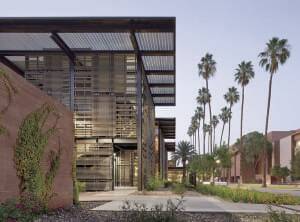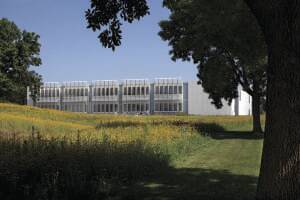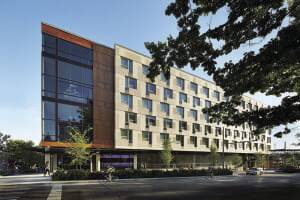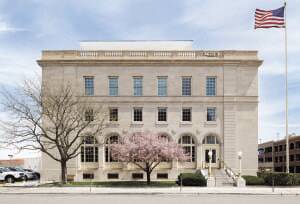Although solar panels and wind turbines may be the poster children for sustainable design, many of the most effective methods for lowering a building’s energy use are decidedly low tech. Narrow floor plates and extensive glazing maximize natural light and ventilation; sunshades, proper building orientation, and high levels of insulation cut cooling and heating costs. But in an increasingly wired and data-driven world, sophisticated technologies have emerged that enable buildings to respond intelligently to environmental conditions and occupant behavior.
The following ten projects—all completed during the past five years—supplement their green design strategies with a range of computerized technologies, providing feedback on energy or water use, shutting off lights and other equipment when not in use, monitoring and adjusting comfort levels, or opening windows and skylights at night to bring in cooling air.
Ron Nyren is a freelance architecture, urban design, and real estate writer based in the San Francisco Bay area.
1. Arbor House
Bronx, New York
The 124-unit Arbor House puts high-tech sustainable design strategies in the hands of households earning less than 60 percent of the area median income (AMI). Each apartment is equipped with programmable thermostats that automatically adjust temperatures in unoccupied rooms to limit waste. Each unit also has an energy monitoring system that gives residents real-time feedback on the current cost of their energy use. Residents can charge cellphones and other high-tech equipment in USB charging outlets that shut power off when the device is disconnected.
Occupancy and daylight sensors minimize artificial lighting in public areas. A stormwater management system releases collected water based on real-time weather data, reducing impact on the sewer system. Designed by local architecture firm Danois Architects, Arbor House has a rooftop hydroponic farm that grows produce. The eight-story building, which opened in 2013, is the result of a public/private partnership involving the New York City Housing Authority, the New York City Department of Housing Preservation and Development, and local developer Blue Sea Development.
2. Arizona State University Health Services Building
Tempe, Arizona
As part of its plan to become carbon neutral by 2025, Arizona State University (ASU) relies on an interactive website, Campus Metabolism, that shows the energy production and consumption of individual buildings, as well as their water use. One of the most consistent top performers on campus is the ASU Health Services Building, completed in 2012 and designed by Lake|Flato of San Antonio, Texas, and the Phoenix office of Orcutt|Winslow.
The project involved demolishing part of the campus’s 1950s-era health clinic, renovating the rest, and adding a two-story wing. Vertical sunshades on the southern and western facades limit solar heat gain while providing privacy to examination rooms. Broad overhangs and a vine-covered trellis provide additional shade; high levels of insulation keep the building cooler in Tempe’s hot summers. Occupancy sensors reduce lighting demand, and an on-site photovoltaic array offsets 40 percent of the building’s total energy costs. As part of the project, 10,000 square feet (930 sq m) of turf grass was replaced with native low-water landscaping, irrigated with recycled stormwater.
3. Atlantic Wharf
Boston, Massachusetts
Along Boston Harbor’s Fort Point Channel, three abandoned, decaying historic buildings have found new life as part of the mixed-use Atlantic Wharf. The local office of Boston Properties worked with local firm CBT Architects to restore and adapt one of the historic structures, the 1899 Russia Building, to provide 86 residential lofts. A new low-rise structure behind the rehabilitated facades of the other two buildings incorporates office, retail, and public uses; a new 31-story tower contains offices. Atlantic Wharf also has gallery and meeting space for the Boston Society of Architects, a public multimedia center, public galleries, event space, and a landscaped waterfront plaza.
Sustainable strategies include a vegetated roof and a stormwater management system that retains rainwater and reuses it in irrigation and in the heating, ventilation, and cooling system. A centrally monitored electronic metering network keeps track of the electricity, natural gas, and water consumption of the base building, including its public spaces. Tenants have access to infrastructure that allows them to monitor their own spaces as well using submetering guidelines developed by Boston Properties. The project was completed in 2011.
4. Chemeketa Community College Health Sciences Complex
Salem, Oregon
It took some work to persuade Chemeketa Community College in Salem, Oregon, to build its new two-story, 70,000-square-foot (6,500 sq m) Health Sciences Complex without air conditioning. The design team, architecture firm SRG Partnership and PAE Consulting Engineers, both of Portland, supplied data and computer simulations showing that the facility’s classrooms, teaching clinics, and outpatient dental clinic could be kept comfortable with a mix of passive design strategies.
Completed in 2011, the building has a control system that automatically opens windows at night and uses rooftop wind-powered turbines to flush warm air from the building. The system consults the local weather forecast to determine the ideal duration of the night-time flush. Sensors in the concrete floors monitor the temperature of the building’s thermal mass; operations staff can electronically track energy use and comfort levels. The system also darkens electrochromic glass in skylights when necessary to limit daylight entering the space. Extensive ceiling fans, exterior sunshades, and high levels of insulation keep the interiors feeling as cool as possible even in summer months.
5. DPR Construction Headquarters
San Francisco, California
When DPR Construction decided to set up a headquarters in San Francisco, it elected to renovate an existing building as a net-zero-energy structure that could serve as a living laboratory for energy efficiency practices. In addition to a rooftop photovoltaic system, automated operable skylights, and solar tube systems that bring daylight into the interiors, the building prominently displays a touch screen in the main entry lobby, giving real-time information on the building’s energy, water, and occupancy performance. An online web app allows all of DPR’s offices around the country to share and compare data.
Another touch-screen interface enables control over ceiling-fan speeds and the electrochromic glass. A plug-load management system allows control and monitoring of power-consuming equipment. The last occupant leaving the building each day can flip a kill switch, shutting off all noncritical energy loads. A LEED Dynamic Plaque automatically monitors and displays the building’s current certification level under the U.S. Green Building Council’s Leadership in Energy and Environmental Design (LEED) program. Designed by local firm FME Architecture + Design, the building opened in 2014.
6. E+ // 226–232 Highland Street Townhouses
Boston, Massachusetts
The city of Boston developed the Energy Plus (E+) Green Building Program as a pilot initiative to create highly sustainable housing in economically disadvantaged neighborhoods, with the goal that the buildings produce more energy than they consume. The first project completed under the program’s umbrella is E+ // 226–232 Highland Street Townhouses. The Boston Redevelopment Authority and the Department of Neighborhood Development chose local firm Urbanica and Philadelphia-based Interface Studio Architects to develop the four three-story townhouses on a vacant city-owned lot in the Roxbury neighborhood. Three of the for-sale units are market rate; the fourth is earmarked for households earning less than 80 percent of AMI.
To achieve positive energy production, the building uses both passive and active design strategies, including a high-performance building envelope heavily insulated against Boston’s cold winters and humid summers. Large, recessed, north-facing windows bring in natural light and facilitate cross ventilation; south-facing sloped roofs hold photovoltaic panels. A grant from the Massachusetts Clean Energy Center, a local publicly financed agency, funded incorporation of sensors that track electricity production and consumption. Residents can access this information through an online and smartphone interface that also lets them remotely control their units’ heating and cooling. The buildings were completed in 2013.
7. Fornebu S
Bærum, Norway
Oslo’s main airport occupied the Fornebu peninsula in Bærum until it was replaced with one farther inland in 1998. Oslo-based KLP Eiendom is redeveloping the brownfield site as an office and residential district. In 2014, KLP opened a mixed-use mall, Fornebu S, as part of the district with the goal of making it the world’s most environmentally friendly shopping center. It includes a green roof that replicates the natural habitat of the site before the airport was built, with 84 plant species to support wildlife and biodiversity. District heating and cooling relies on seawater for heat exchange, LED lights conserve energy, and more than 11,200 square feet (1,040 sq m) of rooftop solar panels supply energy.
Environmental stations in the atrium display information about the building’s environmental features, including its electricity production and consumption and water use. A cellphone game leads players on an interactive tour of the building’s green design strategies. On top of the shopping center, 81 housing units completed in 2015 offer residents views and access to the vegetated roof. Oslo-based AMB Arkitekter was the designer.
8. Iowa Utilities Board and Office of Consumer Advocate
Des Moines, Iowa
When creating a new headquarters to bring together two agencies—the Iowa Utilities Board and the Office of Consumer Advocate—the state of Iowa decided to make the facility a sustainability teaching model for the public. A geothermal heating and cooling system, high-efficiency precast concrete wall panels, and rooftop solar panels are among the energy-saving strategies incorporated by the designers, the local office of BNIM.
Recognizing that occupant behavior plays a big role in conserving electricity, employees worked together to agree on protocols, with help from technology. The automated building system monitors the weather outside: when the temperatures are right, employees get an e-mail notifying them that conditions are ideal for opening the windows. When they do so, the building’s heat pumps automatically shut off. To minimize plug loads, employees agreed to forgo space heaters and refrigerators. At every workstation, occupancy sensors turn off plugs for noncritical equipment to save power. Other sensors collect the building’s energy data for tracking. Employees moved in during 2011.
9. Lander Hall, University of Washington
Seattle, Washington
The University of Washington built Lander Hall to house 650 students in its west campus neighborhood with an emphasis on transparency—as well as interaction among students, and between students and the environment. Five residential floors sit atop a multilevel base wrapped with extensive glazing to expose the main dining facility and social lounge space to passersby. The building wraps around a second-level landscaped courtyard that juts out above the sidewalk, visually connecting residents and outside pedestrians.
In the lobby, electronic dashboards display real-time electricity and water consumption data. When students leave their rooms, occupancy sensors signal thermostats to turn down the heat and shut off lights. Because heating water for showers is a significant energy drain in student housing, the facility relies on a heat exchange system to warm shower water with air exhausted from the dining facility. The residential floors incorporate a mixed-mode natural ventilation system, and an integrated stormwater strategy and rain gardens reduce water use. Designed by the local office of Mithun, Lander Hall was completed in 2014.
10. Wayne N. Aspinall Federal Building and U.S. Courthouse
Grand Junction, Colorado
Built in 1918 and expanded in 1939, the Wayne N. Aspinall Federal Building and U.S. Courthouse is listed on the National Register of Historic Places. By 2010, the building needed such extensive repairs and upgrades that the U.S. General Services Administration considered disposing of it. Then the American Recovery and Reinvestment Act provided the funds to not only renovate the facility, but also target net-zero energy consumption.
The design/build team, the Denver office of the Beck Group and the Cleveland office of Westlake Reed Leskosky, inserted sustainable elements with minimal disruption of the historic fabric, including a discreetly placed photovoltaic canopy, a geothermal exchange system, extensive insulation, and new mechanical and electrical systems. Completed in 2013, the building has an advanced metering system that monitors real-time energy and water consumption. Installation of solar-powered, wireless lighting controls minimized disruption of historic plaster walls and ceilings; equipped with sensors, the controls turn off lights and adjust ventilation when people are not around. Occupancy sensors power down noncritical equipment at workstations as needed. Monthly reports provide tenants with feedback on their energy use.















